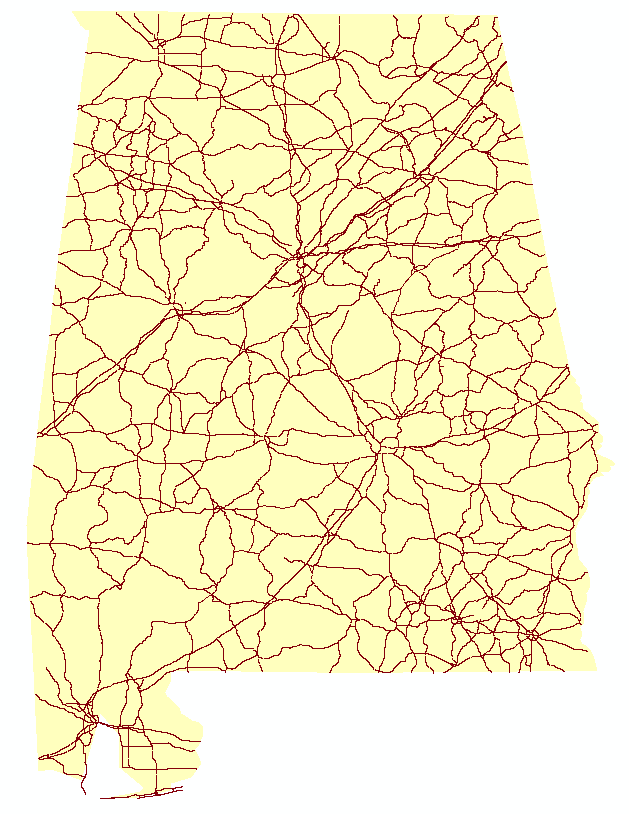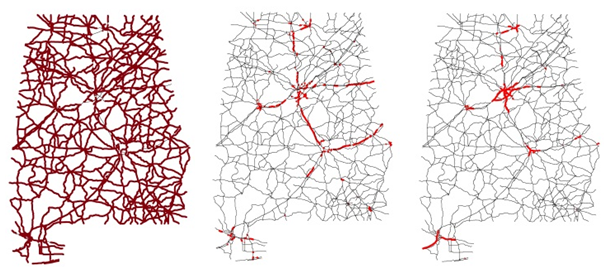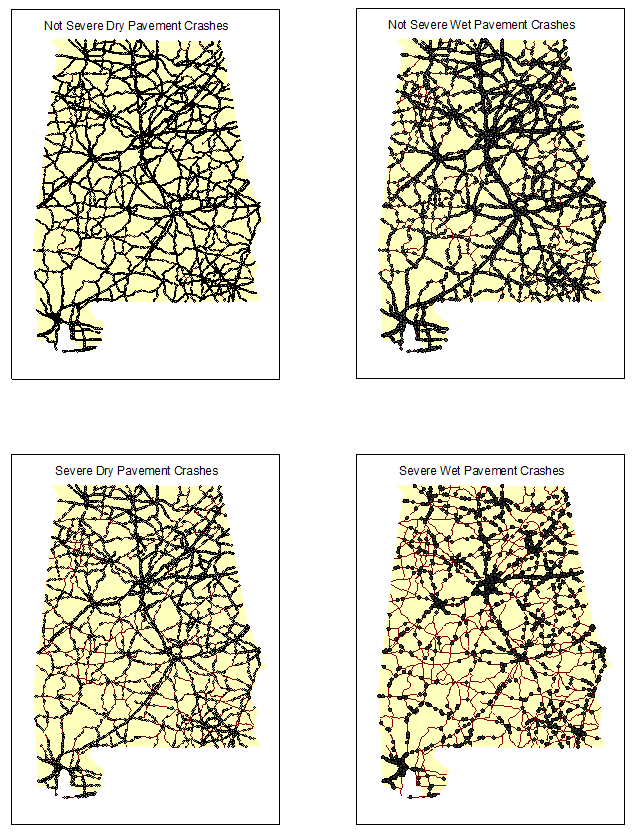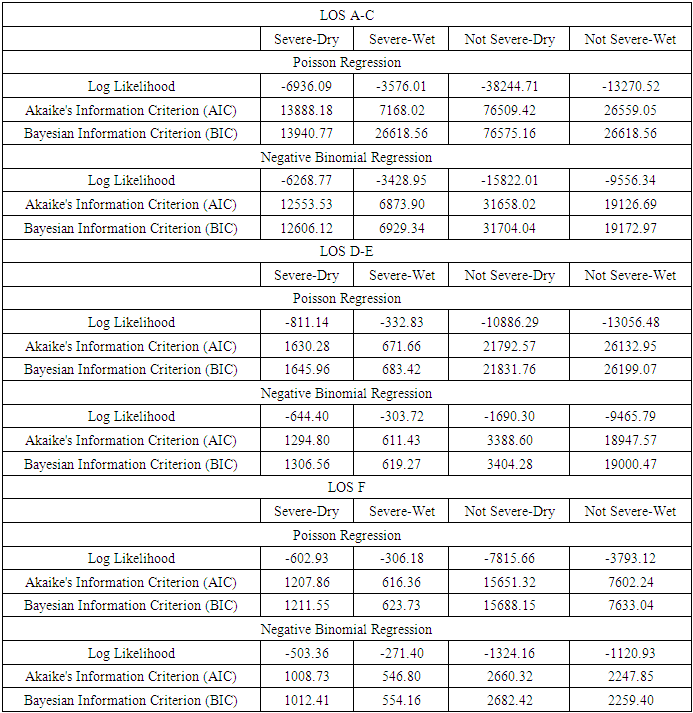-
Paper Information
- Paper Submission
-
Journal Information
- About This Journal
- Editorial Board
- Current Issue
- Archive
- Author Guidelines
- Contact Us
International Journal of Statistics and Applications
p-ISSN: 2168-5193 e-ISSN: 2168-5215
2019; 9(1): 21-28
doi:10.5923/j.statistics.20190901.03

Wet Pavement Crash Analysis for Alabama Roadways
Mehrnaz Doustmohammadi1, Michael Anderson1, Sampson Gholston2
1Dpeartment of Civil and Environmental Engineering, University of Alabama in Huntsville, Huntsville, United States
2Dpeartment of Industrial and Systems Engineering and Engineering Management, University of Alabama in Huntsville, Huntsville, United States
Correspondence to: Mehrnaz Doustmohammadi, Dpeartment of Civil and Environmental Engineering, University of Alabama in Huntsville, Huntsville, United States.
| Email: |  |
Copyright © 2019 The Author(s). Published by Scientific & Academic Publishing.
This work is licensed under the Creative Commons Attribution International License (CC BY).
http://creativecommons.org/licenses/by/4.0/

Wet pavement crashes tend to occur at a higher rate than crashes when the roadway surface is dry, when accounting for the number of hours of actual rainfall and amount of time the roadways would be wet. This study examines data from Alabama for non-intersection, or segment crashes, on the state system against a variety of potential variables hypothesized to contribute to wet pavement crashes. Models were developed relating the number of crashes (severe and non-severe) by pavement condition (wet pavement and dry pavement) at different traffic intensity levels (not congested, moderately congested and highly congested) to a collection of roadway, pavement and traffic variables. The results indicate that for severe crashes on congested roadways with dry pavement, the main variable that can be used to predict crashes is segment length, essentially an exposure variable, indicating that the pavement characteristics have no impact. In addition, the exposure variable is nearly one indicating that the length of the roadway has almost a direct relationship to crash number. However, for non-severe crashes in congested locations and all crashes in either moderate and no congestion there are a variety of factors that impact the number of crashes. The results show that there are certain roadway elements such as macrotexture, the level of friction between the roadway and the tires that allows for stopping, and International Roughness Index, a measure of the level of cracking in the pavement, which contribute to the number of crashes. These values are monitored by transportation agencies on a recurring interval and the impact of exceeding certain thresholds can be used to incorporate crash reductions into a safety maintenance strategy. Other variables that could not be improved through maintenance activities but have an influence on the number of crashes are presented.
Keywords: Wet pavement, Crashes, Statistical analysis, Roadway characteristics
Cite this paper: Mehrnaz Doustmohammadi, Michael Anderson, Sampson Gholston, Wet Pavement Crash Analysis for Alabama Roadways, International Journal of Statistics and Applications, Vol. 9 No. 1, 2019, pp. 21-28. doi: 10.5923/j.statistics.20190901.03.
Article Outline
1. Introduction
- Roadway crashes are a significant problem that results in fatalities, injuries, property damage. Transportation engineers have worked diligently to decrease the likelihood of crashes by designing the safest possible roadways and performing maintenance to ensure that the roadway surfaces are at the best possible condition to minimize the likelihood of a crash. However, there are still a large number of crashes that occur every year. One contributing factor that can lead to a, has the potential to lead to conditions where the total number of crashes increases as well as the severity of the crash. There have been studies performed that examine the differences in the number of crashes and crash is the environment in which the driver operates the vehicle. The presence of rain, or simply driving on wet pavement severity of those crashes during rainfall and non-rainfall conditions [1, 2]. However, no study known has divided the crashes based on the operating condition of the roadway. In Alabama, a review of the crash data show that the majority of crashes (81.5%) occurred during a dry pavement conditions while (18.5%) of crashes occurred when the pavement was wet. Although there are more crashes numerically during dry pavement conditions, on average the state of Alabama experiences rainfall only 5% of the total hours in a standard year [3]. Therefore, almost 1/5th of the crashes that occur in the state are happening during the 1/20th of the time when environmentally it is raining and when the pavement is wet.The purpose of this study is to further examine the impact of rainfall and wet pavement on crash frequency and crash severity using a collection of roadway, pavement and traffic variables. The primary question being addressed asks “are there roadway, pavement and traffic conditions that generally lead to crashes during wet pavement conditions and are there engineering solutions to decrease the severity and number of crashes that occur during wet pavement conditions?”This study includes a collection of roadway, pavement and traffic variables, some unique to this study, to analyze the relationship between these variables and crashes to determine if there is a common theme that can be addressed to assist engineers in determining the impact of these variables on the number of crashes. Unique to this study, a large population of crashes is used in an attempt to develop a series of statewide crash prediction equations that can be applied based on the operation characteristics of the roadway. This differentiates this study from prior efforts that used limited data sets, minimal variables and doesn’t account for different driving environments with respect to congestion and ability to freely operate a vehicle. The study concluded that there are several roadway factors that lead to crashes, but they were not necessarily the ones that were originally assumed to be most important when considering wet pavement driving conditions, and in certain driving environments simply being on the roadway is the best predictor of a crash.
2. Literature Review
- Due to the high number of crashes occurring during wet pavement conditions, several studies have been performed in order to determine factors that affect the frequency and injury severity of these crashes or how wet pavement and rain influence crash frequency in crashes in general. One study assessed hydroplaning risk and skid resistance on wet pavement [4]. Some related studies focused on factors influencing injury severity of crashes, considering wet pavement or rain as a factor [5-11]. Effects of the wet pavement found through these studies vary. Duncan et al. found that wet roads on grades increase injury severity [7]. In 2011, Morgan and Mannering also found that females and older males experience an increase in crash severity when roads are wet or have snow/ice [9]. A 2008 study regarding crash patterns found that spatial patterns of weather-related crashes form clusters depending upon the weather conditions [12]. Aside from these studies, there have been various studies relating crash frequency to wet pavement or rain [13-19]. Several studies performed found that amount and intensity of rainfall were significant factors influencing crash frequency [11, 20-27]. On the contrary, Liu and Sharma found that rainfall showed no significant effects to crash frequency [28]. Eisenberg went into more detail in a 2004 study, determining that there is a negative relationship between monthly rainfall and fatal crashes, but a positive relationship between daily rainfall and fatal crashes [29]. A number of other studies regarding the effects of rainfall on crash risk had results ranging from 2.27% to 77% increases in crashes during rainfall events [9, 30-34]. Multiple studies have found that wet pavement significantly increases crash risk [35-37]. Another study seeking to identify significant factors in wet pavement crashes found that downgrade segment length, radius of curvature, longitudinal grade, and speed consistency were all significant factors [38]. A similar study found that more average daily rainfall and a wider left shoulder resulted in fewer crashes [39]. A 2003 study by Golob and Regan had interesting results, finding that truck-involved crash actually had a lower frequency on wet roads [40]. A particular factor that was of interest in various studies is skid number. Results of studies examining the effects of skid numbers on crash frequency found that the number of wet pavement crashes increases as skid number decreases [41, 42]. Another interesting result in the literature regarding the pavement was that the use of open-graded asphalt concrete resulted in a reduction of wet collisions, as well [43].
3. Study Data
- The study data were collected from a variety of sources maintained by the Alabama Department of Transportation and University of Alabama. All data were brought into a geographic information system environment and spatial joins and summations were performed on the data to develop databases that contained the number of crashes and relevant variables to be used in the analysis.The roadway data was collected from the Alabama Department of Transportation. The database spatial geography was divided into segments ranging from 0.001 miles to 10.489 miles. There were a total of 9,534 segments in the state roadway system. These segments were the basis of the analysis and all crashes, by type, were aggregated to the segments to produce a number of crashes per segment value that was used as the dependent variable in the study. Figure 1 shows the roadway system used for the analysis.
 | Figure 1. Roadway system in Alabama |
|
 | Figure 2. Locations of Roadways by LOS (LOS A-C, LOS D-E, LOS F) |
|
 | Figure 3. Spatial Distributions of Crashes by Type |
4. Statistical Analysis
- The data that were collected were analyzed using the IBM Statistical Package for the Social Sciences (SPSS). As mentioned, there were 12 scenarios developed based on a matrix of wet/dry pavement, severe/non-severe and three traffic intensity levels. Using SPSS, two regression models were selected to be used to model the number of crashes on the roadway segments using the variables identified previously. The regression models were Poisson [47] and Negative Binomial [48]. The models were run for all 12 scenarios from the matrix. The type of regression model and goodness of fit value are shown in Table 3. From Table 3, it can be seen that the Negative Binomial models were superior in all 12 scenarios.
|
|
|
5. Conclusions
- The impact of rain, and wet pavement, on accidents is significant. The weather data show that we have many more crashes during the few hours of rain every year than during the majority of time when it is not raining. The influence of very high traffic intensity on crashes, wet or dry, severe or non-severe, was a function mainly of the length of the roadway individuals had to drive along the segment, and tended not to vary with respect to the pavement condition. On lower traffic congested roadways, other design factors that can be evaluated were shown to contribute to the number of crashes, both for wet and dry pavement conditions. This indicates an important element of this study as these values can be monitored, tested and improved through regular maintenance and resurfacing programs to potentially reduce the number of crashes and the number of severe crashes. While rutting depth was not significant in any of the models developed; macrotexture was a significant variable and transportation agencies can work to develop a maintenance strategy to keep the level of friction for roadways as great as possible to prevent crashes during wet pavement conditions. Overall, this study represents another step in the process of better understanding those variables that contribute to wet pavement crashes. As shown in the data, rainy conditions and wet pavement driving tends to lead to more crashes than should be expected based on time the roadways are wet and the efforts to reduce the number of these crashes and the severity of these crashes are important to reducing crashes on our roadways and increasing safety.
 Abstract
Abstract Reference
Reference Full-Text PDF
Full-Text PDF Full-text HTML
Full-text HTML



